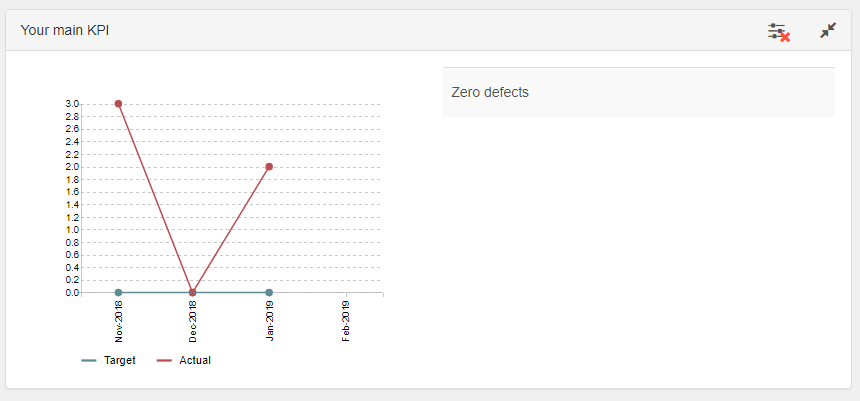The agile organisation needs agile KPI's but how do these differ from traditional KPI's
To answer what is different about agile KPI's we need to look at the conventional approach to goal setting and measurement.
For 76% of corporate employers, this would typically see KPI's set once a year from the top leaders and cascaded down through line managers in a game of corporate Chinese Whispers. Whilst the leadership team and Board of Directors might receive monthly updates, for the workers, KPI's are perhaps reviewed mid-year with a few changes here and there, and ultimately appraised in the annual performance review to decide on rankings, bonus, promotion or performance improvement.
It sounds absurd when you write that down, but despite all of the discussion of the changes to performance management, this, or something close to it, is still what happens for many workers in the corporate world.
Even more alarming according to inc.com is that 80% of small businesses don't keep track of business goals at all, so workers in small business are even less certain to know how they are being measured and what a good day's work looks like.
KPI's in an agile organisation
Agile KPI's are not just traditional KPI's speeded up!
What distinguishes agile KPI's from traditional KPI's is that they are:
- Set in conjunction with the individual with an understanding of how they can most effectively apply their strengths to business needs
- Measured and reported by the individual weekly, fortnightly or at worst monthly to provide a sense of progress
- Assessed and adjusted with the same frequency to maintain relevance to the evolving real-world situation
- A source of near real-time analytics to direct management at all levels to where they can add the most value
- Rolled up to an all-of-business view, not cascaded down from a business planning ideal
This approach, from bottom up, asking the employee how they can align their strengths to needs, not telling them how they will be aligned to distant strategic intent is key to gaining commitment. If individual commitment is missing, agile doesn't work.
Centralised administration does not support agility
Agility doesn't wait.
It doesn't wait for your goal library to be amended.
It doesn't wait for your cascaded planning tool to have a new branch added to it.
It doesn't wait for that half-yearly or quarterly performance checkpoint that HR insist you have with your teams.
Traditional HR Management Systems are not designed for agile, and can't keep up.
No surprise then that those workers furthest from the top are least supported when things change. Bersin by Deloitte reports that whilst 50% of senior leaders update their goals throughout the year as business needs change, only 19% of front-line employees do the same.
Agility happens in the field. Constantly. It requires a solution that's available in the field, constantly.
Give the individual autonomy for their KPI's instead
We've added KPI's to Pay Compliment to provide another way for every worker to self-manage their performance.
An empty KPI is structured with a description, a target and an actual value as shown below and can be added to your feedback/assessment forms.

What's agile about this is that each worker can then complete this empty KPI structure according to what's been discussed and agreed with their manager. No need to wait, they don't need HR to administrate, they can do that immediately,
The campaigns or request processes in the Pay Compliment platform can then be used to schedule an assessment from each worker on how they are performing against their KPI's. This can be set at the cadence that is right for them; it might be weekly for some, monthly for others.
For each assessment, the KPI is pre-filled with values brought forward from the previous assessment and prompts for a newly achieved performance value.

If a KPI does need to change, the prefilled values of description and target can be overtyped right there in-the-moment, and these new values carry forward.
Roll up, rather than cascade down
By rolling all of these individually sourced and reported measures up, rather than cascading a pre-conceived set of measures out, leaders can see what their people are holding themselves accountable for, and the progress they are making.

The leader and organisation wide dashboards are dynamic and allow for performance trends to be easily seen.
Holding the individual and the leader accountable
The level of tracking is important. Whilst it shows the trend in performance which is the primary purpose, it also shows which leaders are holding team members accountable through measurements, and which are not.
According to an American Society of Training and Development (ASTD) study on accountability, people have a 65% likelihood of completing a goal if they commit to someone (and if that commitment is recorded not just eluded to in a check-in). However, if you have a specific accountability appointment with a person you’ve committed to, you will increase your chance of success by up to 95%.
With agile KPI's, individual accountability for tracking, and scheduled appointments for review, what would happen to your business performance and the engagement levels of your people?
The Pay Compliment platform can deliver this approach with minimal setup and management.
Contact us today to find out more.